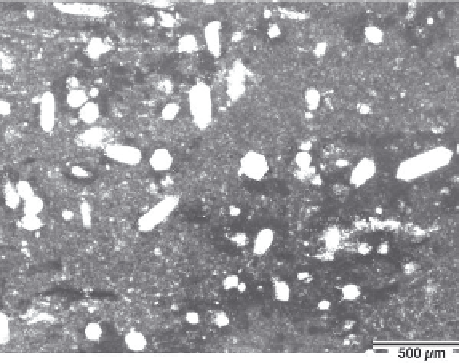Geology Reference
In-Depth Information
environments (Northern Safaga Bay, Red Sea, Egypt). -
Abhandlungen der Geologischen Bundesanstalt Wien,
50
,
369-379
Ruffell, A., McKinnley, J.M., Worden, R.H. (2002): Com-
parison of clay mineral stratigraphy to other proxy paleo-
climate indicators in the Mesozoic of NW Europe. - Philo-
sophical Transactions of the Royal Society London,
A360
,
675-693
Singer, A. (1984): The paleoclimatic interpretation of clays
in sediments - a review. - Earth Science Review,
21
, 251-
293
Velde, B. (1992): Introduction to clay minerals. Chemistry,
origins, uses and environmental significance. - 208 pp.,
New York (Chapman and Hall)
Further reading:
K068, K153
Fig. 13.1.
Authigenic idiomorphic quartz crystals
in a lime
mudstone formed in a hypersaline environment. Note the well
developed euhedral crystal shape. Compare Pl. 109/5 for a
SEM photograph. Late Cretaceous: Subsurface. Ras al
Khaimah, United Arabian Emirates.
13.1.2 Authigenic Minerals
Authigenic minerals
grow after sediment deposition
during diagenesis. They include both replacive miner-
als and cements. Replacive minerals grow in the place
of pre-existing minerals; they are formed from circu-
lating pore fluids or they are alteration products of pri-
mary detrital grains. In contrast, cements are crystals
growing within existing pore spaces. Excellent thin-
section photographs of authigenic minerals can be found
in Scholle (1979).
Selective or pronounced silicification of fossils or other
carbonate grains is a common feature (Maliva and
Siever 1988; Herrig 1993; Whittle and Alsharhan 1994;
Martín Penela 1995).
In thin sections silicification is recorded by idiomor-
phic quartz crystals or as chert appearing as a colorless
microcrystalline aggregate similar in appearance to mi-
crite or microspar, but with much lower birefringence.
The term
chert
refers to a rock composed largely or
entirely of fine-grained quartz. Cherts are formed in
various environments including marine and freshwater
(hypersaline lakes) and at subaerial exposure surfaces
(Knauth 1979). Marine environments can be differen-
tiated using microfacies criteria (Affolter 1997). Many
chert nodules exhibit ghost structures after depositional
textures and biota. In marine settings cherts occur as
nodules varying in size from a few centimeters to about
30 cm, or in layers, often interbedded with shales or
limestones. Most chert nodules were formed early dur-
ing diagenesis. They are common in pelagic chalks. In
shallow-marine areas (ramps, platforms) the input of
silica from land is an important source (Laschet 1984).
In shallow-marine settings chert nodules are sometimes
related to mixing zones. The silica for nodules and bed-
ded cherts occurring in pelagic deep-marine limestones
is usually supplied by dissolution of sponge spicules
and radiolarians. Recent pure siliceous ooze of the South
Atlantic may be an example of a diagenetic environ-
ment with early chert formation (Bohrmann et al. 1994).
13.1.2.1 Silicification of Carbonates, Authigenic
Feldspar and Glauconite
Silicification and idiomorphic quartz
A wide variety of sediments is commonly affected
by silicification in deep-marine as well as in shallow-
marine limestones. The major sources of silica in sedi-
ments are: (1) siliceous tests and skeletal elements of
organisms, (2) river input of solutions from the weath-
ering of continents in semi-arid climates (Laschet 1984),
and (3) silica supplied in solution by hydrothermal vol-
canic systems.
Silicification of carbonate rocks involves replace-
ment of carbonate by silica as well as precipitation of
pore-filling silica cement (e.g. Noble and Van Stemp-
voort 1989). Studies of silicified carbonates usually
focus on the description of fabrics (e.g. Wilson 1966),
the extent of silicification (minor, selective, pervasive),
and the relative timing of silicification with respect to
diagenetic events affecting the carbonate host rock (see
Hesse 1990b for an overview; Pl.109/7, 8). Silicifica-
tion fabrics may take the form of euhedral quartz (com-
monly >0.5 mm), drusy megaquartz (0.5 to 10s mm),
microquartz (<10
m) or chalcedony (10s to 100s mm,
fibrous silica crystals forming radial or spherulitic struc-
tures).
Idiomorphic quartz crystals
(Fig. 13.1; Pl. 109/5, 6)
are often found in carbonates affected by saline or hy-
persaline pore waters (see Box 12.7). This situation is

